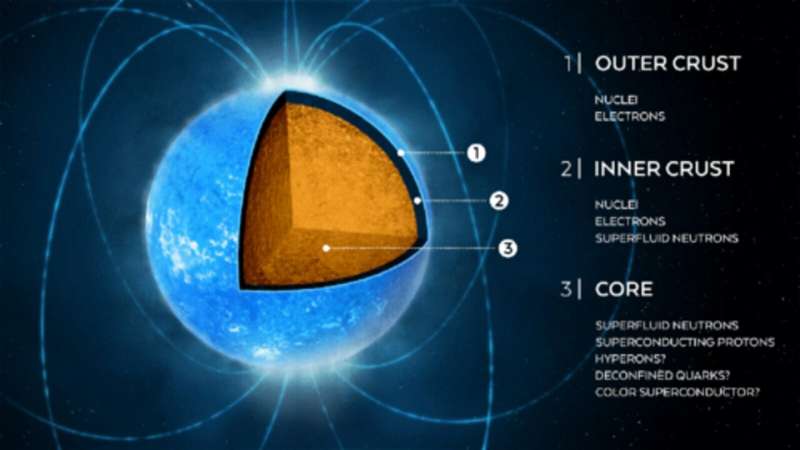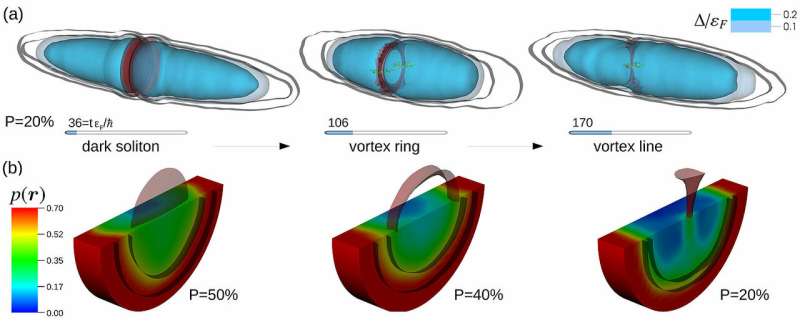New simulation methods to visualise quantum effects in superfluid fermions

What exactly happens inside neutron stars – the final stage of a giant star – is subject to speculation. In terms of physics, the interiors of neutron stars, cold atomic gasses and nuclear systems all have one thing in common: they are gaseous systems made up of highly interactive, superfluid fermions. Researchers fed the supercomputer Piz Daint with a new simulation method, and the results are finally offering insight into unknown processes of such systems.
Neutron stars, cold atomic gasses and nuclear systems are all gaseous systems made up of highly interactive, superfluid fermions, i.e. systems whose matter is made up of particles with half-integer spin (intrinsic angular momentum). The category of fermions includes electrons, protons and neutrons. At very low temperatures, these systems are described as superfluid, meaning that the particles in them do not generate any internal friction whatsoever and possess the property of almost perfect thermal conductivity.
These superfluid Fermi gases do not behave according to the laws of classical physics, but rather can be better described using the laws of quantum mechanics. Gabriel Wlazłowski, an assistant professor at Warsaw University of Technology and the University of Washington in Seattle, and his team have recently developed a new method based on density functional theory (DFT). With the help of the supercomputer Piz Daint, they are aiming to create a highly precise description of these superfluid fermion systems and their dynamics. In other words, they will describe how vortices form and decay in this "atomic cloud." The results were published in Physical Review Letters.
Similar to a folk dance party
In superfluid Fermi gases, individual fermions and correlated fermions occur alongside each other. From correlations between particles with opposite spins, superconducting properties of materials emerge. Correlated fermions, like electrons in superconductors, exist in pairs as a condensate and are called Cooper pairs. Each pair can move through the system without energy loss. However, for many years it has been investigated what happens in spin-imbalanced cases, because not every particle can find a partner with opposite spin to form the Cooper pair. "The situation is similar to a folk dance party, where the numbers of men and women are imbalanced, someone would be frustrated as he/she cannot form a pair," says Wlazłowski. What do unpaired atoms do? This is exactly what the researchers have been studying.

An accurate description of superfluid Fermi gases, especially of spin-imbalanced systems, has previously been very difficult. Spin imbalance occurs when a system is affected by a magnetic field, Gabriel Wlazłowski says. The target of the researcher now is to apply DFT formalism to neutron stars as well as to magnetars – neutron stars with a strong magnetic field – for predicting what happens inside. "Clearly, there is no way to probe explicitly interiors of stars. Thus, we need to rely on simulations, for which we need reliable tools," Wlazłowski says. Therefore, researchers were searching for a terrestrial system that shares a lot of similarities with the target system. "It turns out that strongly interacting ultra-cold atomic gases are very similar to neutron matter."
For their numerical experiments, the researchers used the most complete quantum theoretical description currently available for many-body systems to describe this type of system. This enabled them to produce a more in-depth DFT theory for superfluid systems. They also combined it with a special time-dependent superfluid local density approximation for a unitary spin-imbalanced Fermi gas. "Without approximation, superconducting DFT will lead to integro-differentional equations that are beyond reach even for exascale supercomputers," Wlazłowski says. With their current study, the researchers are now able to demonstrate that this approximation is working very well in the considered systems.
Correlation between simulation and experiment
"By creating a visualisation of the calculations and comparing these images with photos from experiments, we were able to observe these quantum mechanical systems directly," says Wlazłowski. "Comparing the theoretical and experimental results yielded excellent correlations." This allowed the researchers to offer up proof that their new method for calculating the behaviour of such systems works. The next step will be for them to apply the method to processes that will never be visible to the naked eye, such as those inside neutron stars.
Another important finding came from the researchers' observations of three different vortex decay patterns in the superfluids. According to the researchers, the various decay patterns (see figure) depend on the spin polarization of the particles of the system. They also say that the polarization is caused by the sucking effect of the unpaired particles in the superfluid gas. In other words: nature tries to collect unpaired particles in regions, where they do not hinder the flow. Cores of quantized vortices are such places, and polarization of the different vortices should then prevent them from bonding again, or so the researchers predict. They therefore assume that polarization effects have a considerable influence on quantum phenomena and will lead to new, yet-to-be-discovered areas of physics. "However, just to show that we reproduce some data is not enough – can we predict something completely new?", Wlazłowski asked himself. For him, the next important barrier to overcome will be to find out if the method has predictive power.
This kind of highly complex problem requires enormous computing power. Technically, the researchers solve hundreds of thousands of time-dependent nonlinear coupled 3-D Partial Differential Equations (PDEs). For this reason, the authors of the study submitted a request for computing time to the Partnership for Advanced Computing in Europe (PRACE) and were granted access to use Piz Daint at CSCS, because, according to the authors, in Europe only Piz Daint can handle this type of calculations.
More information: Gabriel Wlazłowski et al. Suppressed Solitonic Cascade in Spin-Imbalanced Superfluid Fermi Gas, Physical Review Letters (2018). DOI: 10.1103/PhysRevLett.120.253002
Journal information: Physical Review Letters
Provided by Swiss National Supercomputing Centre



















